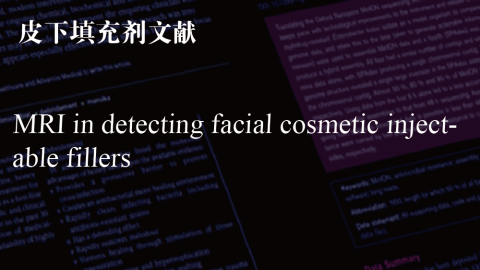
- 3226人
- 分享收藏
MRI in detecting facial cosmetic injectable fillers
简介
【 文献重点摘要 】
Background: Despite being considered a non-invasive procedure, injections can cause adverse outcomes including infections, overfilling, asymmetry, foreign body granulomas, and reactions that lead to scarring. Complications may be associated with the procedure itself, the physician’s technique, and/or the type of agent injected. In these instances, it is important to be able locate and identify the substance used. This study investigated the viability of using MRI to correctly identify injected substances, their symmetry of distribution, and related complications.
Methods: Fourteen patients with suspected injectable filler complications were identified by our institution’s plastic surgery service. All subjects were scanned with MRI, using highly specific face-oriented sequences at high resolution with small field of view and thin slices across the axial and coronal planes by T1 Dixon non-contrast, T2 Dixon, and T1 Dixon after gadolinium injection. Two independent and blinded radiologists evaluated the images and reported (1) the likely injected substance, (2) symmetry, and (3) complications. These radiological results were compared against clinical data provided by the plastic surgery service.
Results: Ten patients (83 %) presented objective injectable complications: 4 had abscess, 4 granulomata, and 2 had allergic reactions to the injected substance. The Fleiss Kappa for inter-rater agreement on substances was 0.80. Asymmetry was identified in six patients (50 %) with a Kappa between radiology evaluators of 1. MRI characteristics of these common fillers are summarized in table form.
Conclusions: Given the growing awareness among referring physicians of the value of dedicated facial MRI, utilization of this imaging technique may lead to discovery of the injected substance’s true identity, evaluation of symmetry and/or complications.
背景:尽管注射被认为是一种非侵入性手术,但它可能会导致不良后果,包括感染、充盈过度、不对称、异物肉芽肿和导致瘢痕形成的反应。并发症可能与手术本身、医生的技术和/或注射的药剂类型有关。在这些情况下,能够定位和识别所使用的物质是很重要的。本研究调查了使用MRI正确识别注射物质、其分布对称性和相关并发症的可行性。
方法:通过我院整形外科服务,对14例疑似可注射充填物并发症的患者进行分析。所有受试者均行MRI扫描,扫描采用T1Dixon平扫、T2Dixon和T1Dixon平扫,序列分辨率高、视野小,横断面和冠状面薄层扫描,注射钆后,采用高分辨率、高分辨率、高分辨率的人脸定位序列进行扫描,扫描图像为T1Dixon平扫、T2Dixon平扫和T1Dixon平扫。两位独立和盲目的放射科医生对图像进行了评估,并报告了(1)可能的注射物质,(2)对称性,以及(3)并发症。这些放射学结果与整形外科服务提供的临床数据进行了比较。
结果:10例患者(83%)出现客观的注射并发症:4例出现脓肿,4例出现肉芽肿,2例出现对注射物质的过敏反应。评分者间物质协议的Fleiss Kappa为0.80。6名患者(50%)被确认为不对称,放射学评估员之间的Kappa评分为1。这些常见填充物的MRI特征以表格的形式总结。
结论:由于转诊医生对面部MRI价值的认识不断提高,利用这种成像技术可能会发现注射物质的真实身份,评估对称性和/或并发症。



